Angkor Wat and the surrounding temples are undoubtedly Cambodia’s number one tourist attraction, and if you’re like me, you won’t be disappointed. They’re majestic, magical, and surreal all at the same time.
Angkor was the ancient capital city of the Khmer empire. It comprised over a thousand temples, some of which have been restored, some of which are merely a few pebbles amongst rice paddies now. Today, the Angkor Archaeological Park is a UNESCO World Heritage Site visited by over two million people a year. If you’re considering being one of those visitors, here are the basics and logistics you need to know.
Tickets & Prices
There are currently three types of tickets:
| 1 Day Pass | Valid for 1 day | USD 37 |
| 3 Day Pass | Valid for ten days from the issue date | USD 62 |
| 7 Day Pass | Valid for one month from the issue date | USD 72 |
As you can see, the three day and seven day pass are valid for longer, which means you do not need to pick three consecutive days (this is a change to a previous rule, so older sources may tell you differently). You can take a break from temple touring if you’re all templed out after two days. These ticket prices were updated in november of 2017 and are rather substantial increases to the previous prices (a one day pass was $20 previously, for example!).
Tickets (called Angkor Pass) can be bought at the main ticket sales booths on the road from Siem Reap to Angkor Wat. One day passes can also be bought at the checkpoint on the road from the airport to Angkor Wat and at the checkpoint at Banteay Srei. All tickets are personalized with your name and, in the case of three and seven day tickets, photo (which will be taken there, so you need to be present to get the ticket) and are non-transferable.
There is no other place to buy official tickets, and tickets sold anywhere else are most likely fakes so stick to these places and make sure to get the ticket yourself! Any tuk tuk or taxi driver will know these places as well as the procedures to get a ticket, let them know that you want to stop by the ticket booth and they should be able to take you there.
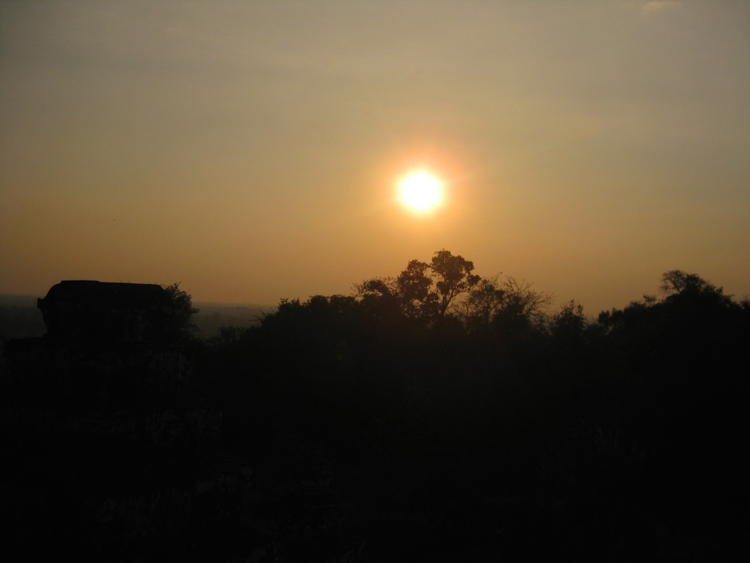
Travel Hack:If you buy your ticket after 5pm, it will be made out for the next day and you can enter the park for free the evening you buy it, so you are essentially getting a free sunset visit. My recommendation is to pack yourself a picknick, buy your pass in the afternoon for the next day and head to Phnom Bakheng for great sunset views. Word of caution – you won’t be the only one with that plan so if you’re looking for peace and quiet rather than views, Angkor Wat itself might be the better option.
Angkor Wat Opening Times
The Angkor Archaeological Park including Angkor Wat is open from just before sunrise until after sunset, so times are not exact but rather change slightly with the seasons. Officially though:
– Angkor Wat and Srassrang is open from 5:00am to 5:30pm
– Phnom Bakheng and Pre Rup Temple are open from 5:00am to 7:00pm (Phnom Bakheng is the one recommended for sunset, see above)
– All other temples are generally open from 7:30am to 5:30pm
Angkor Wat: Getting there and around
The nearest city to Angkor Wat is Siem Reap, which can be reached easily by plane. I flew in with Cambodia Angkor Air from Bangkok, Bangkok Airways also offers several flights a day on this route. Visas on arrival are available for visitors from most countries at the airport for a fee of USD 30 (as of 2018) – double check with your local embassy if you’re eligible. There is also an eVisa that you can apply for in advance, it’s actually slightly more expensive though with the admin fee, but may save you time at the airport, if you’re in a particular rush. If you’re traveling to Siem Reap from within Cambodia, buses to Siem Reap are available from most bigger towns, Giant Ibis or Mekong Express are the best options.
Once you’re there: The Angkor Archaeological Park is big! Angkor Wat is the closest temple to Siem Reap and is about six kilometers (roughly four miles) from the city. Some of the furthest temples like Banteay Srei are over thirty kilometers away. Keeping that in mind, the best options for getting there and around are a taxi, tuk tuk or bicycle if you’re feeling sporty.
- Taxi: Taxis are the most expensive option, but come with the advantage of air conditioning, which can be nice depending on when you’re traveling. You also have the advantage of being able to talk to your driver while he’s driving, and many of them are extremely kind, knowledgeable people who can give you great insights into Cambodian life and history.
- Tuk tuk: Probably the most popular option, it’s less expensive than a taxi and somewhat more rustic but a fun way to travel short distances. Cambodian tuk tuks are typically little trailers pulled by motorcycles, so the driver is quite far away from you and you probably won’t be able to talk much with him during the ride. If you are visiting Angkor in the winter months, bring a light jacket or sweater with you for long tuk tuk rides in the morning and evening. Even if it’ll be blistering hot at the temples at mid day, you might get cold in the tuk tuk on the way.
- Bicycle: If you are feeling sporty, renting a bike is a nice and inexpensive way to visit the temples on your own time as well. Keep in mind it will be extremely warm during the day, so you may want to limit your route to the temples closer to Siem Reap. Most guest houses and hotels have bikes for rent or can arrange them. If yours doesn’t have them, your best bet is to head towards the center of town (Pub Street) and look for signs for bicycles for rent, there will be plenty. Make sure to check the brakes and tires before you go. Should you have trouble with your bike on the road, most tuk tuk drivers will be happy to transport you and your bike back town for the normal rate plus a small tip if you ask.
How to find a reliable taxi or tuk tuk: Taxis and tuk tuks are abundant in Siem Reap and the Angkor park. However, in peak season it may be more difficult to find a taxi. Many guest houses and hotels offer to arrange a trusted driver they regularly work with for you. This may cost you a few dollars extra but is likely to be hassle free and should you have any trouble, the hotel will have an interest in helping you settle any issues.
If you approach a tuk tuk driver on the street and negotiate a fare with them, make sure you’re clear about what’s included. Going rates as are around 20 USD for a day at Angkor Wat, which should include everything. If you’re being quoted a much lower rate, there may be additional charges added on later that you weren’t aware of (examples: it’s actually $10 per person, or you pay an extra charge to stay for sunset etc.). Whatever the charges may be and whether you consider this a scam or normal business practice, make sure you’re aware of what you’re paying up front. Never get into a tuk tuk before being 100% clear about what you’re going to have to pay in the end.
Which temples should I visit, and in which order?
There were over a thousand temples in Angkor, more are still being discovered every year, and you won’t be able to visit them all. If you’re only going for one day, my recommendation would be to do what is sometimes called the “small tour” (see map below), a route that can be done in one day if you hire a tuk tuk or taxi and covers Angkor Wat, Ta Prohm and Angkor Thom (including Bayon), as well as a few smaller temples if you have time. You can end your day at Phnom Bakengh, which offers glorious views for sunset.
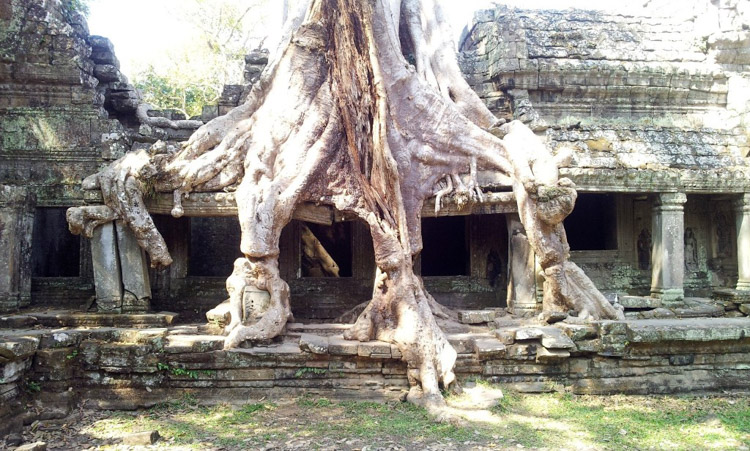
Ta Prohm, famous from the movie Tomb Raider with Angelina Jolie
If you have a three day pass, my recommendation would be to do this small tour on your first day, and then the “grand tour” on the second day. Highlights of the grand tour are East Mebon and Preah Khan temples, as well as the Neak Pean ponds. You can also take things slower and skip Ta Prohm on day one and add it to the grand tour instead, as it lies on the intersection of the two routes.
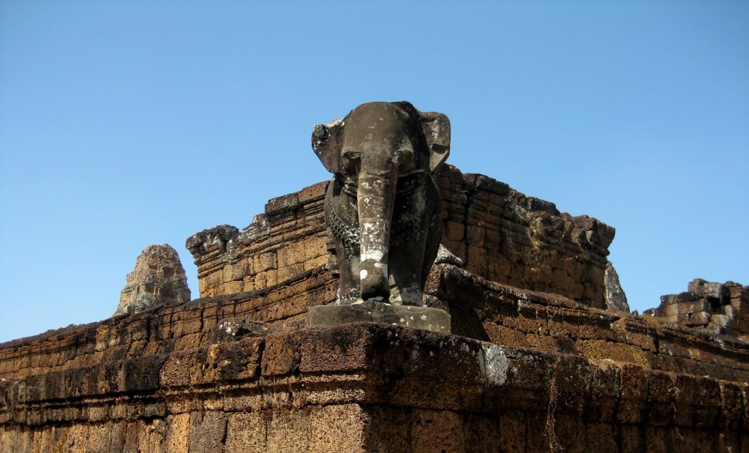
East Mebon, with its elephant statues, is worth a visit if you’re staying longer than a day
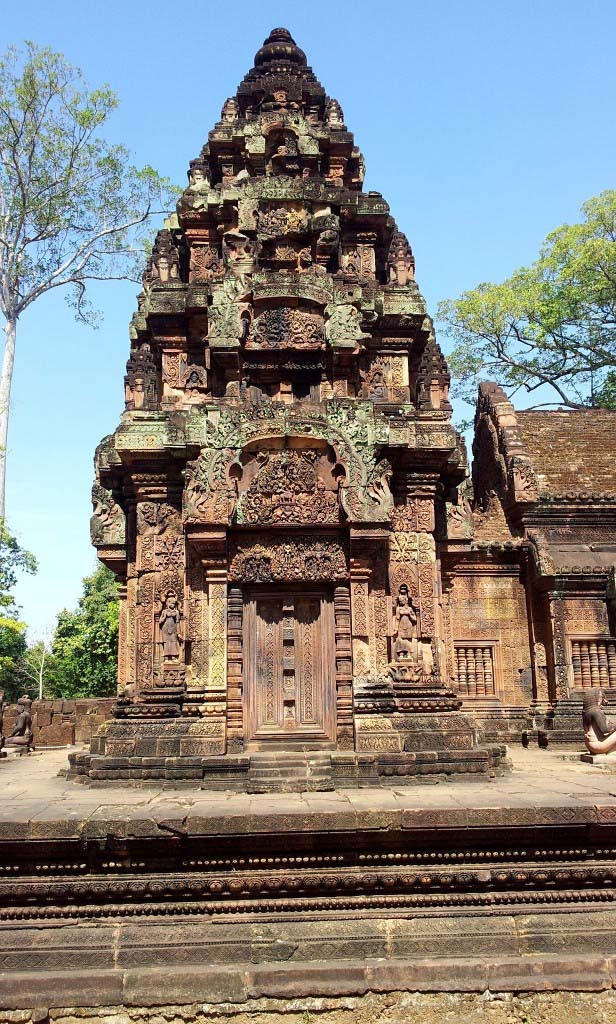
Banteay Srey, a beautiful red stone temple with intricate carvings
For your third day, my recommendation would be to choose one of the outlying temples and take a day trip there. Banteay Srey, a beautiful temple with elaborate carvings in a beautiful nature setting is about 35km outside of Siem Reap. A trip there can be combined with a visit to the land mine museum.
Maps of the temples of Angkor
Your hotel or guesthouse probably has free maps of the temple grounds for you, alternatively you can also get them at the ticket booths. More detailed maps, guide books and history books are being sold at stands and souvenir shops as well as by traveling vendors inside and outside the vendors, both legally and not so legally. Rest assured you will not be lost. Alternatively, check out the map below (click on it to see the original, larger version) and see the next section for a downloadable free guide book.
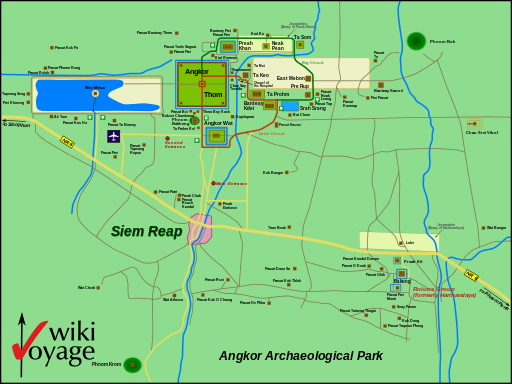
Map: By Stefan Fussan [CC-BY-SA-2.5 or CC-BY-SA-3.0], via Wikimedia Commons
Where can I find out more about Angkor Wat?
One of the most comprehensive guides out there is Maurice Glaize’s Guide to the Angkor Monuments. It is available completely and for free online at TheAngkorGuide.com.
Are drinks and food available at the temples?
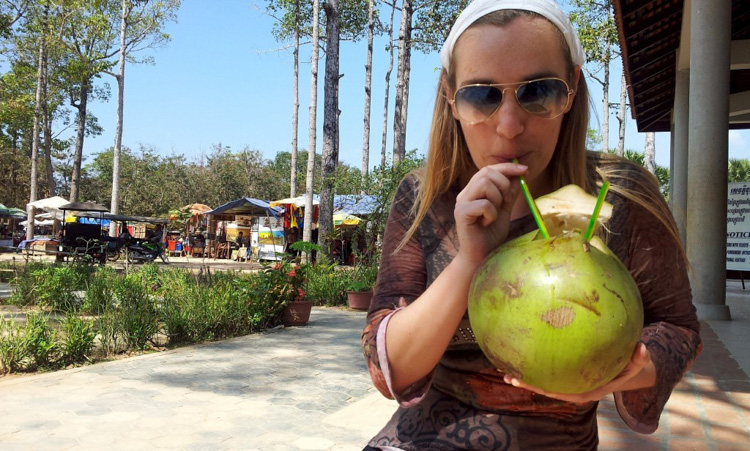
Sipping fresh coconut juice at the food stalls just outside Ta Prohm
There is no food sold inside the temples, but there are plenty of local food stalls and souvenir shops right outside most of the bigger, more popular temples, so you can stop for drink and food break in between temple visits. Prices are higher than elsewhere in Cambodia, but still cheap compared to Western standards. A bottle of water can be bought for $0.50 – $1.00, for example. You’ll also find plenty of vendors selling fresh fruit.
Is there a dress code for Angkor Wat?
This might sound like a strange question but was one of the top questions Google suggested about Angkor Wat when I did a search. So, while I did not see anyone getting kicked out for wearing a tank top at the time, the recommended attire for the temples, as with most temples in Asia, is to wear long pants or a long skirt that covers the knees, and a shirt that covers the shoulders and doesn’t show too much cleavage. This is recommendable anyway as you don’t want to get sunburned. I also recommend comfortable shoes as you’ll be doing lots of walking and climbing stairs, small hills etc. and obviously the buildings aren’t exactly in mint condition!
Do you have any other questions?
Did I forget something? Leave me a comment and I’ll add your question & the answer to it to this guide!
This article was first published in 2014 and was last updated in May 2018.

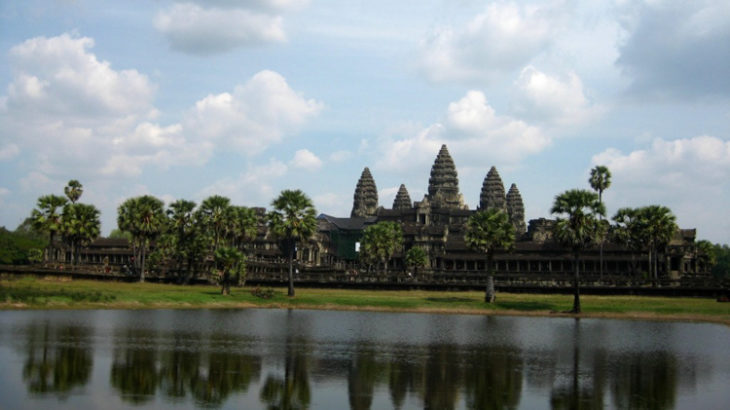
 English
English Deutsch
Deutsch
Hi,very informative thank you very much,just one question are the tickets valid to go to the waterfalls and the 10000 linga place(Kulen) and preach ang thom pagoda
Thank you
Hi Mathew,
Glad you found the guide helpful! Phnom Kulen (which includes all the places you mentioned) isn’t part of the Angkor Pass area, there’s a separate $20 entrance fee for it.
Hi! Thank you for this entry! I have a few questions though. Is it possible to get inside Angkorwat around 5:30am then go back to the hotel at 9am then go back again to finish the validity of a 1 day pass? Though it says that a day pass is valid from 5am-5pm (1 day $20) does the validity stay the same even if you go in and out the Angkorwat complex multiple times? Thank you!
Hi Nichole! At the moment it is possible to leave the archaeological park and get back in again later on with the same ticket. They are making some changes to tickets in general though starting February 2017 (mainly increasing ticket prices), so might be worth double checking when you buy your ticket. As of now though, you could absolutely go for sunrise, then back to your hotel for breakfast, then tour a few temples, go to Siem Reap town for lunch, and return to the park in the afternoon. Btw, if you’re hiring a tuktuk, that’s usually for the day, so it shouldn’t cost you any more to get a ride back to town/your hotel in between for rest stops.
Thank you so much for the detailed response!